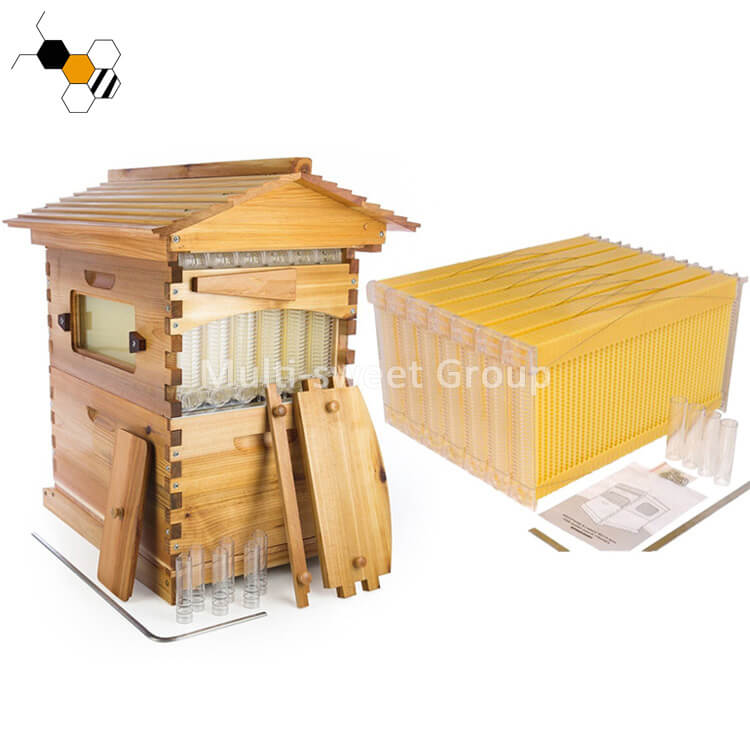How Is Flow Hive Work?
Beekeeping has been around for thousands of years, but in recent years, a new innovation has taken the beekeeping world by storm: the Flow Hive. the Flow Hive is a revolutionary new way of harvesting honey that has gained a significant following among beekeepers around the world. this article will introduce the flow hive design and how is it work today.

Flow Hive Design:
The autoflow hive has a unique design that sets it apart from traditional beehives. Here are some of the design features of the Flow Beehive:
Flow Hive frames: The Flow Hive frames are the key component that makes the system work. The frames are made of food-grade plastic and have a unique design that includes channels within the honeycomb structure. The channels allow the honey to flow out of the hive without disturbing the bees or damaging the hive.
Flow Key: The Flow Key is the tool that is used to open and close the channels in the Flow Hive frames. The Flow Key is inserted into a slot on the side of Flow Hive frames and turned to activate the honey release mechanism.
Honey collection: The honey flows out of the Flow Hive frames and into a collection jar or container that is placed under the hive. The collection jar can be removed and replaced as needed.
Brood box: The brood box is the lower part of the Flow Hive where the queen bee and brood (developing bees) are housed. The brood box is usually made of wood and contains frames that hold the honeycomb cells where the bees store honey and raise their young.
Flow Super: The Flow Super is the upper part of the Flow Hive that contains the Flow Hive frames. The Flow Super sits on top of the brood box and is used for honey storage and harvesting.
Construction: The Flow Hive is typically made of wood, although the Flow Hive frames are made of food-grade plastic. The wooden components are usually made of sustainably sourced Western Red Cedar or other types of hardwood.
Overall, the Flow Hive is designed to be a more convenient and less invasive way of harvesting honey from beehives. Its unique design allows beekeepers to extract honey without disturbing the bees or damaging the hive, which can be beneficial for both the beekeeper and the bees.
How is flow hive work?
The Flow Hive frames are designed to fit into standard Langstroth beehives, which are the most commonly used type of beehive in North America. Each Flow Hive frame consists of a wooden frame that holds a series of plastic honeycomb cells. The cells are arranged in a hexagonal pattern, just like a natural honeycomb.
The Flow Hive is built with honeycombs that are made up of partly formed wax cells. When the bees produce honey, they fill these empty cells with nectar, which is a sugary liquid produced by flowers. The nectar eventually turns into honey as the bees evaporate some of the water content.
Traditionally, beekeepers would need to remove the honeycombs from the hives, cut the wax caps from each cell to release the honey, and then spin the frames in an extractor to remove the honey. This process can be stressful for the bees and time-consuming for the beekeeper.
The Flow Hive, however, uses a unique system of partially formed honeycomb cells that allows beekeepers to easily extract honey from their hives without disrupting or stressing the bees. When the beekeeper wants to harvest honey, they turn a key on the side of the hive, then the honey flows out of the cells and into a tap at the bottom of the hive. The processing activates a series of levers that push on the ends of the honeycomb cells, which causes the cells to split open along the channels in the comb, allowing the honey to flow out and into a collection jar or container. The honey flows out under gravity and does not require any pumping or other external forces. This process of harvesting honey takes less time and is less disruptive to the bees.
To harvest the honey, the beekeeper inserts a special key into the hive and turns it to separate the cells. This action breaks an internal membrane, which creates channels that allow the honey to flow down the cells and out of the hive.
Once the honey has been harvested, the beekeeper can turn the hive upright and the bees will begin to repair the broken cells. The honeycomb cells will then reform and the bees can continue to use them to store honey and raise brood. This system is designed to reduce the stress on the bees and create a more sustainable relationship between the beekeeper and the hive.
One potential benefit of the Flow Hive system is that it allows beekeepers to harvest honey more frequently and in smaller quantities than traditional beekeeping methods. This can reduce the stress on the bees and may lead to healthier hives overall. Additionally, because the Flow Hive frames are made of plastic instead of wax, they can be reused multiple times without needing to be replaced.

However, there are also some potential drawbacks to using the Flow Hive. Some beekeepers have raised concerns that the system may encourage over-harvesting of honey, which can be harmful to the bees. Additionally, the plastic honeycomb cells may not be as durable as natural wax comb and may need to be replaced more frequently. Finally, the Flow Hive system is a little more expensive than traditional beekeeping beehives, which may make it less accessible for some beekeepers.


